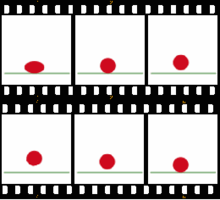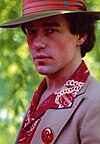
Introduction
Animation is a filmmaking technique by which still images are manipulated to create moving images. In traditional animation, images are drawn or painted by hand on transparent celluloid sheets (cels) to be photographed and exhibited on film. Animation has been recognized as an artistic medium, specifically within the entertainment industry. Many animations are computer animations made with computer-generated imagery (CGI). Stop motion animation, in particular claymation, has continued to exist alongside these other forms.
Animation is contrasted with live-action film, although the two do not exist in isolation. Many moviemakers have produced films that are a hybrid of the two. As CGI increasingly approximates photographic imagery, filmmakers can easily composite 3D animations into their film rather than using practical effects for showy visual effects (VFX). (Full article...)
Selected article
Dream of the Rarebit Fiend was a newspaper comic strip by American cartoonist Winsor McCay which began September 10, 1904. As in McCay's signature strip, Little Nemo, the strip was made up of bizarre dreams. It was McCay's second successful strip, after Little Sammy Sneeze secured him a position on the cartoon staff of the New York Herald. Rarebit Fiend was printed in the Evening Telegram, a newspaper published by the Herald. For contractual reasons, McCay signed the strip with the pen name "Silas". The strip had no continuity or recurring characters. Instead, it had a recurring theme: a character would have a nightmare or other bizarre dream, usually after eating a Welsh rarebit (a cheese-on-toast dish). His editor there thought his highly-skilled cartooning was "serious, not funny", and he was made to give up comic strips to do editorial cartooning. The strip was revived 1923–1925 as Rarebit Reveries, though few examples have survived. Rarebit Fiend was the inspiration for a number of films, including Edwin S. Porter's live-action Dream of a Rarebit Fiend in 1906, and four pioneering animated films by McCay himself: How a Mosquito Operates in 1912, and 1921's Bug Vaudeville, The Pet and The Flying House.
Selected image
Did you know (auto-generated) -

- ... that Raoul Servais invented a new technique for combining animation and live action for his short film Harpya?
- ... that the French animated film The Summit of the Gods is based on a Japanese manga series?
- ... that the creators of the cartoon Jade Armor filmed live-action martial arts stunts to visualize the show's animated action sequences?
- ... that Bruce Timm created most of the character designs for Batman: The Animated Series?
- ... that the interactive cartoon Cat Burglar takes about 15 minutes to watch, but features 90 minutes of animation?
- ... that the Pakistani film Shehr e Tabassum was the first animated cyberpunk film to be made by an Urdu development team?
Selected quote
Selected biography
Phil Hartman (September 24, 1948 – May 28, 1998) was a Canadian-born American actor, comedian, writer and graphic artist. Born in Brantford, Ontario, Hartman and his family later immigrated to the United States. He attended California State University, Northridge, graduating with a degree in graphic arts and going on to design several album covers. He joined The Groundlings in 1975 and there helped Paul Reubens to develop his character Pee-wee Herman, co-wrote the screenplay for the film Pee-wee's Big Adventure and made recurring appearances on Reubens' show Pee-wee's Playhouse. Hartman became well-known in the late 1980s when he joined the sketch comedy show Saturday Night Live. He won fame for his impressions, particularly of President Bill Clinton, and stayed on the show for eight seasons. Called "the Glue" for his ability to hold the show together and help other cast members, Hartman won a Primetime Emmy Award for his SNL work in 1989. In 1995, after scrapping plans for his own variety show, he starred as Bill McNeal in the NBC sitcom NewsRadio. He also had frequent roles on The Simpsons, and appeared in the films Houseguest, Sgt. Bilko, Jingle All the Way, and Small Soldiers. He was shot dead by his wife Brynn while he slept in his Encino, California home in 1998. In the weeks following his death, Hartman was celebrated in a wave of tributes.
Selected list
The Simpsons' second season originally aired between October 11, 1990 and May 9, 1991, and contained 21 episodes, beginning with "Bart Gets an F". Another episode, "Blood Feud" aired during the summer after the official season finale. The show runners for the second production season were Matt Groening, James L. Brooks, and Sam Simon, who had also been EPs for the previous season. The DVD box set was released on August 6, 2002 in Region 1, July 8, 2002 in Region 2 and in September, 2002 in Region 4. The episode "Homer vs. Lisa and the 8th Commandment" won the Emmy Award for Outstanding Animated Program (For Programming less than One Hour), and was also nominated in the "Outstanding Sound Mixing for a Comedy Series or a Special" category.
More did you know...
- ...that Milt Gross, writer of comics that used Yiddish-inflected English, also wrote a 1930 "silent" graphic novel He Done Her Wrong: The Great American Novel and Not a Word in It — No Music, Too?
- ...that Gustaf Tenggren was a chief illustrator at the Disney Company when Snow White and the Seven Dwarfs (pictured), Bambi and Pinocchio were produced?
- ...that Virgil Walter Ross animated Bugs Bunny and Daffy Duck for decades under Tex Avery and Fritz Freleng and received the highest awards in his profession?
Anniversaries for May 9
- Films released
- 1936 - Let It Be Me (United States)
- 1941 - A Good Time for a Dime (United States)
- 1942 - The Draft Horse (United States)
- 1947 - Sleepy Time Donald (United States)
- 1953 - Ant Pasted (United States)
- 1953 - For Whom the Bulls Toil (United States)
- 1959 - Hot-Rod and Reel! (United States)
- 1966 - Matinee Mouse (United States)
- Deaths
- 2000 - Arthur Davis, American animator (b. 1905)
Subportals
Related portals
Wikimedia
The following Wikimedia Foundation sister projects provide more on this subject:
- Commons
Free media repository - Wikibooks
Free textbooks and manuals - Wikidata
Free knowledge base - Wikinews
Free-content news - Wikiquote
Collection of quotations - Wikisource
Free-content library - Wikiversity
Free learning tools - Wiktionary
Dictionary and thesaurus
























